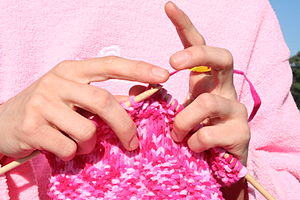This article may be in need of reorganization to comply with Wikipedia's layout guidelines. (June 2021) |

Fine motor skills are the coordination of small muscle movements which occur e.g., in the fingers, usually in coordination with the eyes. In application to motor skills of hands (and fingers) the term dexterity is commonly used.
The term 'dexterity' is defined by Latash and Turrey (1996) as a 'harmony in movements' (p. 20). Dexterity is a type of fine coordination usually demonstrated in upper extremity function (Kohlmeyer, 1998).[1]
The abilities which involve the use of hands develop over time, starting with primitive gestures such as grabbing at objects to more precise activities that involve precise eye–hand coordination. Fine motor skills are skills that involve a refined use of the small muscles controlling the hand, fingers, and thumb. The development of these skills allows one to be able to complete tasks such as writing, drawing, and buttoning.
According to the results of a study conducted in the USA assessing the difference in foundational motor skills between males and females between the age of five and six years old, there was no significant difference between gender. However, the results displayed a difference in the ability to catch and aim between the six-year-old males and females. The study's results proposed that these gender differences are not concrete when adding age as an observing factor.[2]
During the infant and toddler years, children develop basic grasping and manipulation skills, which are refined during the preschool years. The preschooler becomes quite adept in self-help, construction, holding grips, and bimanual control tasks requiring the use of both hands.
— Essa, E., Young, R. & Lehne, L., Introduction to early childhood education, 2nd Ed. (1998)[3]
Young children's lives consistent with visual and performing arts that hold as much importance as language and play (Child Development Division, & California Department of Education. 2011, p. 40). "The arts build skills such as problem-solving and critical thinking; they bring parallel opportunities for the development of language/communication, mathematics, and the development of social and interpersonal skills. The following activities are often referred to as children's play: scribbling with a crayon, pretending to be a pirate or a bird, humming bits of a tune, banging on a drum, or swaying to music".[4]: 40
- ^ Rosenblum, Sara; Josman, Naomi (January 2003). "The Relationship Between Postural Control and Fine Manual Dexterity". Physical & Occupational Therapy in Pediatrics. 23 (4): 47–60. doi:10.1080/j006v23n04_04. ISSN 0194-2638. S2CID 6499202.
- ^ Kokštejn, Jakub; Musálek, Martin; Tufano, James J. (2017-04-27). Papadelis, Christos (ed.). "Are sex differences in fundamental motor skills uniform throughout the entire preschool period?". PLOS ONE. 12 (4): e0176556. Bibcode:2017PLoSO..1276556K. doi:10.1371/journal.pone.0176556. ISSN 1932-6203. PMC 5407840. PMID 28448557.
- ^ Cite error: The named reference
Essa 1998was invoked but never defined (see the help page). - ^ "California State Department of Education. Science in the Elementary School. Sacramento, California: California State Department of Education, 1945. 418 pp. $1.00". Science Education. 33 (4): 308. October 1949. Bibcode:1949SciEd..33U.308.. doi:10.1002/sce.3730330463. ISSN 0036-8326.